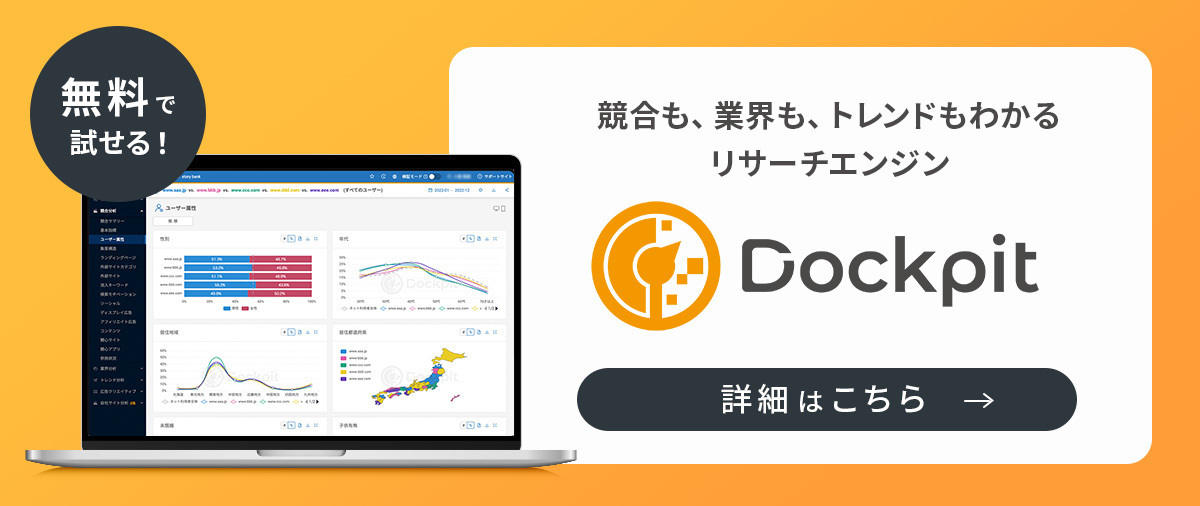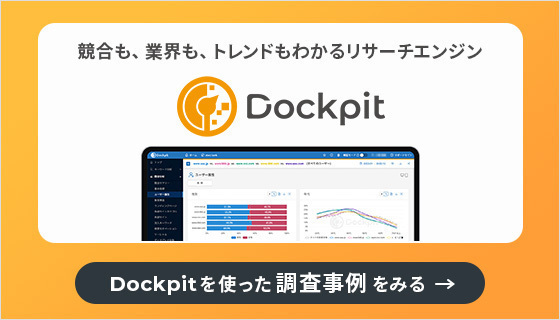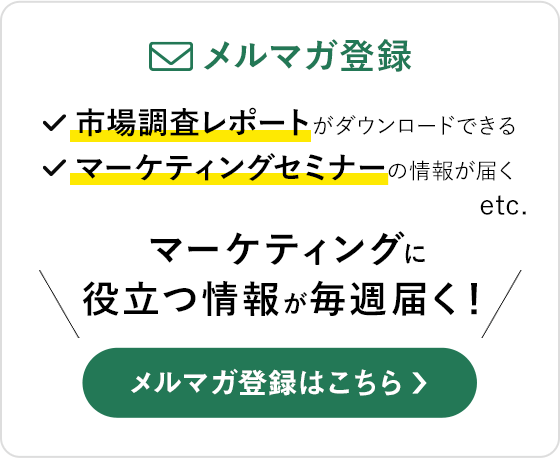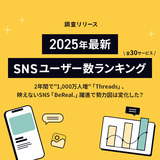In recent years, various investments such as virtual currencies, NISA, and IDECO have attracted attention. While some people have an image that investing is “too difficult for beginners”, robo-advisors are a service that even beginners can easily start investing.
Robo-advisors are services that provide users with asset management advice and assistance based on AI and expert analysis. There are two types of robo-advisors: “advice type” and “discretionary investment type”. In the “advice type”, the advisor suggests the optimal portfolio for the user's objectives, and the users make the final decision on their own. In the “discretionary investment type”, on the other hand, as long as you have the funds to invest, the company will handle everything from proposal to actual investment management.
In this study, we analyzed the robo-advisor market using “Dockpit”, an online activity log analysis tool from Values that enables users to analyze competitor sites and conduct trend research with a browser at hand, using activity log data that is updated monthly.
How many people are interested in robo-advisors? Comparison with mutual funds
First, let’s compare the number of users searching for “robo-advisor” with “mutual fund”.
The change in the number of search users is shown below.

Trend of users searching for “robo-advisor”
Period: December 2019 - January 2022
Devices: PCs and smartphones

Trend of users searching for “mutual fund”
Period: December 2019 - January 2022
Devices: PCs and smartphones
Comparing the number of search users, “robo-advisor” is one order of magnitude smaller than “mutual fund” and is still a developing market. In addition, while “mutual fund” has nearly doubled the number of users from April 2020 to January 2022, “robo-advisor” has seen a steady decline overall, decreasing by 1/3 over the same period.
Next is a list of crosswords for “robo-advisor”.

Crossword list of searches for “robo-advisor”
Period: December 2019 - January 2022
Devices: PCs and smartphones
The most common word in “robo-advisor” searches is “comparison”, which shows the behavior of considering which service to use.
On the other hand, “not recommended” and “disadvantages” were the words used to express negative concerns about robo-advisors. This may be due to the worries of using AI and other machines to select investment options. The words “reputation” and “actual results” were also seen, indicating that users are cautious about robo-advisors.
Next, we compared the user attributes. Let's look at the differences in gender and age.

Attributes of “mutual fund” and “robo-advisor” search users: gender
Period: December 2019 - January 2022
Devices: PCs and smartphones

Attributes of “mutual fund” and “robo-advisor” search users: age
Period: December 2019 - January 2022
Devices: PCs and smartphones
There were no differences in gender and age attributes between “mutual fund” and “robo-advisor” searchers. The majority of searchers by gender were males, and the volume zone by age were in their 30s.
Let's take a look at the annual household income composition.

Attributes of “mutual fund” and “robo-advisor” search users: annual household income
Period: December 2019 - January 2022
Devices: PCs and smartphones
There was also no significant difference between “mutual fund” and “robo-advisor” searchers in annual household income composition. Compared to all internet users, we can see that interests were higher from those with relatively high annual incomes.
In terms of the number of search users and the list of crosswords, it can be said that awareness of the robo-advisor market was not that high. However, the target market of robo-advisor is not so different from that of mutual fund, and if trust in robo-advisors increases in the future, there is a possibility that the number of users will explode.
The state of the market for robo-advisor services as seen by competitive analysis
We then analyzed the market for robo-advisors by comparing the number of website users for each service.
First, the table below compares the number of users of the websites of the three “advice type” services, Investment Trust Kobo, Monex Advisor, and SMBC Robo-advisor, by the use of Dockpit.

Comparison of the number of users of “advice type” robo-advisor services
Period: December 2019 - January 2022
Devices: PCs and smartphones
Investment Trust Kobo, operated by Matsui Securities, had the largest number of users at 110,000, followed by SMBC Robo-advisor and Monex Advisor, which was slightly behind the top two.
On the other hand, the table below compares the number of users of “discretionary investment type” services.

Comparison of the number of users of “discretionary investment” robo-advisor services
Period: December 2019 - January 2022
Devices: PCs and smartphones
Wealth Navi, which had the largest number of users, having 6.91 million users in the two years from December 2019 to January 2022. Daiwa Fund Wrap Online also had 1 million users. Overall, it seems that there were much more users interested in the “discretionary investment type” services. If people are going to use robo-advisor services instead of mutual funds, many of them are likely to use the “discretionary investment type”, which allow them to leave everything to the services.
Let's take a look at the trend of users of “discretionary investment type” robo-advisor services over the past two years.

Trend of users of “discretionary investment type” robo-advisor services
Period: December 2019 - January 2022
Devices: PCs and smartphones
Wealth Navi was still the most popular site throughout the period, and susten and folio had also increased recently. Susten's explosive increase is thought to be due to the acquisition of users through some sort of promotional campaigns. However, there was also a sharp drop immediately after the increase. It shows that the campaigns might not lead to a stable inflow of users.
What kind of people are Wealth Navi users?
At last, we analyzed Wealth Navi, which has the largest number of users among robo-advisor services. Let's take a look at the interest map.

Interest map of Wealth Navi site visitors
Period: February 2021 - January 2022
Devices: PCs and smartphones
The above map is calculated based on the following definitions with “reach rate” on the vertical axis and “feature value” on the horizontal axis.
| Reach rate | Percentage of the targets who responded to the relevant item in the questionnaire. |
| Feature value | Indicator to visualize the genres of interest that the targets are characteristically interested in compared to the general internet users.Calculated as (Reach rate of the target population) - (Reach rate of the entire online population) |
The vertical axis is the “reach rate”; the higher the number, the greater the number of users interested in the genre. The horizontal axis is the “feature value”, which is a value that is higher for genres that the level of interests is markedly different from that of general internet users. Considering both values together, the genres located in the upper right corner of the graph are genres with unique interests and concerns of Wealth Navi users.
First, of course, interest in “money and investment” is by far the highest. Next are “economy”, “digital devices”, and “business-related”, which suggests interests in business in general and gadgets in particular. Incidentally, “real estate investment” and “deregulation of electricity” also follow, suggesting that the users are interested in efficient management of their assets.
Other relatively interesting topics include “outdoor activities”, “cars”, “photography / camera”, and “sports”. This suggests that some Wealth Navi users like to go outside and enjoy leisure activities such as outdoor activities and sports, and are also a little interested in cameras for taking pictures.
Summary
In this study, we compared the overall market for robo-advisor services with mutual funds, and then compared and analyzed “advice type” and “discretionary investment type” services, respectively. While the number of search users for mutual fund was increasing, the number of searchers for robo-advisor services was on a steady decline. We also found that some users are turning a cautious eye toward robo-advisors.
In the analysis of each service, more users were interested in the “discretionary investment type” than the “advice type”, when Wealth Navi attracted a large number of users among them.
About Dockpit
The data in this investigation is from Dockpit, an analytics tool with online behavior log data and user demographic information under the permission of panelists in Japan presented by VALUES, Inc.
※The numbers of users are estimated by the data in the monitor and the internet population in Japan.
※日本語での記事はこちらをご確認ください

投資のロボアドバイザーサービスの利用者はどんな人?Web行動ログで調査
https://manamina.valuesccg.com/articles/1677ウェルスナビや楽ラップ、folioをはじめとしたロボアドバイザーサービスのユーザー動向とは。本記事では投資信託と比較したロボアドバイザーサービスのユーザー規模の変化や、サービスごとのユーザー属性の違いについて調査します。























マナミナは" まなべるみんなのデータマーケティング・マガジン "。
市場の動向や消費者の気持ちをデータを調査して伝えます。
編集部は、メディア出身者やデータ分析プロジェクト経験者、マーケティングコンサルタント、広告代理店出身者まで、様々なバックグラウンドのメンバーが集まりました。イメージは「仲の良いパートナー会社の人」。難しいことも簡単に、「みんながまなべる」メディアをめざして、日々情報を発信しています。